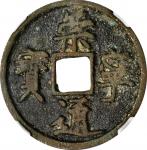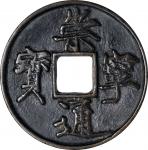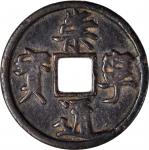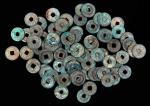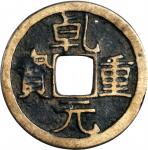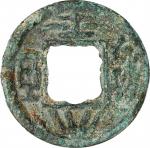宋代古钱一组。十枚。CHINA. Northern Song Dynasty. Group of 10 Cash (10 Pieces), ND (1102-06). Hui Zong (Chong Ning). All NGC Genuine Certified. 宋代古钱一组。十枚。大字、短足"宝"。大部分有厚厚一层尘状包浆,呈绿色至深蓝色,有深色色块,但字样深峻清晰。<strong>现况出售,概不退换。</strong><em>北宋南迁前的倒数第二位皇帝,徽宗于1100年即位,1126年退位让贤给长子赵桓,是为钦宗。在位期间,北宋版图达致巅峰,南至大越及大理,西触吐蕃及西夏,北及辽。儘管地域广阔,徽宗并不是一名合格的统治者。他对艺术的热枕远超于管理国事。宋徽宗酷爱诗词歌赋,书法造诣更是为人称道,瘦金体便是由他所创。直至清朝覆没,中国货币的形式大多雷同,通常都是浇铸而制的带孔黄铜钱币,俗称“铜钱”。中央孔通常呈方形,可用绳索串起多至一百枚,以方便交易及算账。正面四角各有一汉字,反面则为空白。正面字体多样化,徽宗因其书法技艺高超,在其早期统治下(1102-1106),大部分十文上书其独创的瘦金体。此书法以“铁划银鈎”著称,字形苍劲典雅。除瘦金体外,篆书亦是铜钱字体常客。与瘦金体相反,篆书以柔和圆润、结构均匀闻名,但同样极具美感。儘管徽宗治下的宋国政局动荡,最终被迫瑟缩北方,但其铜钱却展现出其对艺术的追求,并促使铜钱设计向美学迈进,为其政治管理上的失败略掩一二。</em>CHINA. Northern Song Dynasty. Group of 10 Cash (10 Pieces), ND (1102-06). Hui Zong (Chong Ning). All NGC Genuine Certified.Hartill-16.407; FD-1050. Variety with large characters and short feet on bao. Most coins have a thick dusty patina that varies in color from green to dark blue with patches of tan, but all characters are bold and clear.<p><em>The penultimate ruler of the Northern Song dynasty before its flight and reestablishment in the south, Emperor Huizong reigned for the first quarter of the 12th century, from 1100 until his abdication in favor of his eldest son, Emperor Qinzong, in 1126. During his reign, the Northern Song reached its territorial zenith, bordering the Dai Viet and Dali to the south, the Tibetans and Western Xia to the west, and the Liao to the north. In spite of possessing a vast realm, Emperor Huizong proved to be a rather ineffective ruler, spending much of his time as a patron of the arts rather than overseeing state affairs. Poetry, music, and paintings were all given great attention by the emperor, as well as something for which he was widely known-calligraphy.</em><p><p><em>Throughout much of Chinese numismatics and until the very end of the end of the empire, coinage took a very formulaic approach, with much of the vast output taking the form of cast-usually in bronze-coins known as "cash." These simplistic pieces generally had square openings at the center allowing for multiples-often in groups of 100-to be strung together for ease of accounting and trade. Four characters would generally occupy the four corners of the obverse, with the reverse usually remaining blank. While these characters featured varying styles of script, Emperor Huizongs noted skills in calligraphy demanded that he offer his input and artistry. During the early portion of his reign (1102-1106), a series of mostly 10 Cash denominated issues employed his own personal calligraphic style, known as the "shòu jīn" (slender gold) script. This iconic writing was admired for its "iron strokes" and "silver hooks," presenting a forceful yet elegant overall appearance. Contemporaneous with these "slender gold" issues was a series featuring the rather ubiquitous "seal script," whereby the characters took upon a softer, far less jagged look, with many perpendicular and parallel lines. This form of script also presents a degree of elegance through its seemingly malleable approach.</em><p><p><em>Despite the direction and overall stability of the Northern Song dynasty during the reign of Emperor Huizong, the cash coins from this period offer a glimpse into his desire for elegance and artistry, and an overall push toward the aesthetic. This numismatic beauty can be seen as camouflaging the political roiling which was taking place and ultimately caused the shrinking and forced moving of the Northern Song to simply the dynastys portion in the south.</em><p>

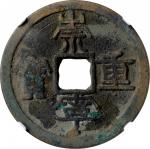
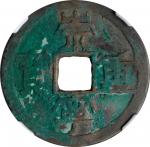

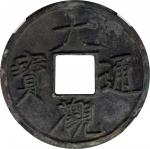
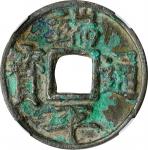
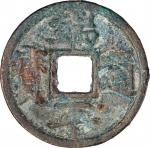
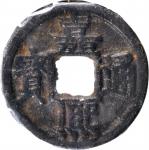

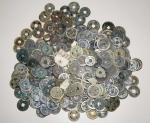
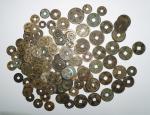
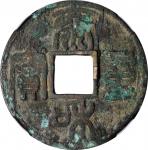
![至大通宝折一。CHINA. Yuan Dynasty. Cash, ND (1310-11). Wu Zong (Zhi Da [Khayishan]). FINE.](http://data.shouxi.com/upload/img/0c/be/0cbe5afe6185508b5fc2107939501abc_150x150.jpg)
![大元通宝折十。(t) CHINA. Yuan Dynasty. 10 Cash, ND (1310-11). Wu Zong (Zhi Da [Khayishan]). Graded "80" by](http://data.shouxi.com/upload/img/de/dc/dedc1d290bd461c5edd40d03e1c86119_150x150.jpg)
![大元通宝当十。CHINA. Yuan Dynasty. 10 Cash, ND (1310-11). Wu Zong (Zhi Da [Khayishan]). VERY FINE Details.](http://data.shouxi.com/upload/img/7d/4a/7d4ada062e8a781af6bf5a771251a06d_150x150.jpg)
![大元通宝折十蒙文。(t) CHINA. Yuan Dynasty. 10 Cash, ND (1310-11). Wu Zong (Zhi Da [Khayishan]). Graded "80" b](http://data.shouxi.com/upload/img/0d/dd/0dddc4f92d838d4e53ae6035c353ac90_150x150.jpg)
